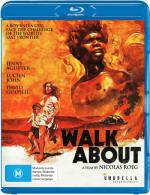Walkabout (Blu-ray) (1971) |
|
Walkabout (Blu-ray) (1971) |
|


|
| BUY IT |
| General | Extras | ||
| Category | Drama |
Reversible Cover Audio Commentary-Nicolas Roeg (Director) and Jenny Agutter (Actor) |
|
| Rating |

|
||
| Year Of Production | 1971 | ||
| Running Time | 100:26 | ||
| RSDL / Flipper | Dual Layered | Cast & Crew | |
| Start Up | Programme | ||
| Region Coding | 2,4 | Directed By | Nicolas Roeg |
|
Studio
Distributor |
 Umbrella Entertainment |
Starring |
Jenny Agutter Lucien John David Gulpilil |
| Case | Standard Blu-ray | ||
| RPI | ? | Music | John Barry |
| Video | Audio | ||
| Pan & Scan/Full Frame | None | English DTS HD Master Audio 2.0 | |
| Widescreen Aspect Ratio | 1.78:1 | ||
| 16x9 Enhancement |
 |
||
| Video Format | 1080p | ||
| Original Aspect Ratio | 1.85:1 | Miscellaneous | |
| Jacket Pictures | No | ||
| Subtitles | None | Smoking | Yes |
| Annoying Product Placement | No | ||
| Action In or After Credits | No | ||
A father (John Meillon) drives his two children, a teenage daughter (Jenny Agutter) and a six year old son (Luc Roeg, the director’s son, credited as Lucien John), from their privileged life and private schools in the city into the outback. There he attempts to shoot the children, but fails, before setting the car alight and committing suicide. Lost and alone, the two children wander in the desert and cliffs of the outback, barely avoiding thirst and starvation when they are fortunate and find a small waterhole. There they are discovered by a young Aboriginal boy (David Gulpilil), who is about the same age as the girl. Although they have no language in common, the Aboriginal boy shows them how to survive in the bush as he guides them towards European settlement. While in the bush the trio are free and innocent, but when they reach the vestiges of European habitation, even if it is only an abandoned homestead, misunderstandings arise that have a tragic outcome.
Walkabout, based on a novel by James Vance Marshall, was written by Edward Bond but as the screenplay was apparently only 14 pages long a lot of the film was improvised, which would not be that difficult as most of it is the children by themselves, and later with the Aboriginal boy, walking through the bush, camping or hunting animals. Dialogue is sparse and even when speech occurs communication is absent for Gulpilil, in his first film, spoke in his own language (which was not subtitled). Gulpilil is charismatic, his expressions and body language impressive for one so young and in a different culture but even so the weight of the film is carried by the cinematography of the Australian outback, the score and the sound design.
Walkabout is photographed and directed by Nicolas Roeg. This was his first film as director although he had been the DP on films such as The Masque of the Red Death (1964) and Far From the Maddening Crowd (1967) so he brings this cinematographer’s eye to Walkabout, creating an almost mystical look to the ridges, deserts, waterholes, vegetation and insect and animal life of the outback; with frequent cuts to vision of ants, lizards, birds and mammals, such as a spiny anteater, a wombat, camels and kangaroos, he shows that the outback is by no means empty of life, even though the city children may not notice it. The sound design adds to the sense of dislocation and mysticism; there are periods of silence before suddenly there is a blur of atonal sound composed of insect and bird noises plus bells, general noise or distorted voices, as if from a radio. Underscoring the visuals and sound design is the score by four time Oscar winner John Barry (Born Free (1967), The Lion in Winter (1968), Out of Africa (1985) and Dances with Wolves (1990)). Barry uses a combination of indigenous instruments, a female choir and orchestra at various times as counterpoints; for example the digeridoo is not used when the film is in the outback, but when the vision is of the city and city life.
Walkabout is a simple story. But at the centre of the film is a much more complex rumination about the contrast between city and bush, between “civilization” and traditional values, about what constitutes knowledge; is it solving complex mathematical problems or knowing how to survive in the bush? The Europeans we meet in the outback, such as the weather scientists or a white man making a living by making Aboriginal statues, are generally unpleasant, at odds with the environment. It is not accidental that the six year old boy is the one who most readily adapts to his situation and starts to communicate, after a fashion, with the Aboriginal boy; he is young and innocent and has not yet had “civilization” embedded into his psyche. For the girl it becomes more of an issue, due to both her age and her gender, but problems do not arise, and communication become an issue, until the trio reach a deserted homestead, a symbol of European mis-settlement in the bush where sexual tension becomes an issue.
Roeg had a long career in camera departments, and when he turned to directing his films in the 1970s, Performance (1970), Walkabout (1971), Don’t Look Now (1973) and The Man Who Fell to Earth (1976) is an impressive body of work many directors would love to have. Walkabout is on many critics’ “must see” lists and its scores on rottentomatoes.com almost 50 years after it was released (critics 87% / audience 86%), remain high, a testament to just how impressive the film is.
Walkabout is presented in an aspect ratio of 1.77:1, in 1080p using the MPEG-4 AVC code.
The detail in some sequences, including those in the city, can be soft, as are some of the wide shots of the bush and ridges extending into the distance. Close-ups and medium shots are however strong and Gulpilil’s facial expressions clear. Colours are bright and natural, such as red of the desert and cliffs, the silver-green of the saltbush, the more vibrant greens of other trees near water, the blue of the sky, the red and yellows of the sunset and sunrise. Skin tones are natural, blacks and shadow detail solid. Brightness and contrast is consistent.
There was some motion blur and occasional small flecks but otherwise I did not notice any obvious marks or artefacts. Grain is strong in some sequences but is normally nicely controlled.
No subtitles are provided.
| Sharpness | |
| Shadow Detail | |
| Colour | |
| Grain/Pixelization | |
| Film-To-Video Artefacts | |
| Film Artefacts | |
| Overall |
The audio is English DTS-HD MA 2.0 mono. The film was released theatrically with mono audio.
Dialogue is not always clear, especially from Luc Roeg but as dialogue is not very important in this film it does not really matter. The effects and the sound design can be sharp and strident at times such as when a blur of atonal sound composed of insect and bird noises plus bells, noise or distorted voices bursts from the speaker. The gun shots are loud and reverberate. The score by John Barry is unusual but effective, using a combination of indigenous instruments, a female choir and orchestra at various times.
There are no lip synchronisation issues.
| Dialogue | |
| Audio Sync | |
| Clicks/Pops/Dropouts | |
| Surround Channel Use | |
| Subwoofer | |
| Overall |
The cover can be reversed to omit the Australian classification logo.
This commentary is not indicated on the Blu-ray cover nor, as the film commences with the programme, in a menu. However this commentary featuring Nicholas Roeg and Jenny Agutter that was present on the previous DVD release of the film can be accessed via the audio tab on the remote. Roeg and Agutter were recorded separately almost 30 years after shooting the film, so that Agutter mentions quite a few times she was “not sure” about something. Matters covered include Roeg’s intentions, his techniques and philosophy, locations, the script, camping out, anecdotes from the shoot, David Gulpilil, the emerging sensuality of the children, the swimming naked scene. Not the best commentary around but both are pleasant to listen to and they provide some interesting thoughts on filmmaking and the film.
NOTE: To view non-R4 releases, your equipment needs to be multi-zone compatible and usually also NTSC compatible.
The US Region A Criterion release of Walkabout includes the audio commentary but adds interviews with Jenny Agutter (20:00) and Luc Roeg (20:56), a featurette on David Gulpilil (56:10), a trailer (4:12) and a booklet, making it the best release if your system is Region A compatible.
Walkabout is almost pure filmmaking, a movie where dialogue and exposition is minimal and where the almost mythic visuals, sound design and music move the film forward. The performances by Jenny Agutter and Luc Roeg are adequate, but a young David Gulpilil, in his first film, is compelling.
Walkabout was released on DVD two decades ago and reviewed on this site here. This Blu-ray release misses out on the majority of the extras that are available in the US but with the HD presentation and lossless audio an upgrade is worthwhile for fans of the film. This is a very different type of film that has become a classic, a must see film on many lists. If you don’t have the film, it is worth checking out.
| Video | |
| Audio | |
| Extras | |
| Plot | |
| Overall |
| Review Equipment | |
| DVD | Sony BDP-S580, using HDMI output |
| Display | LG 55inch HD LCD. This display device has not been calibrated. This display device is 16x9 capable. This display device has a maximum native resolution of 1080p. |
| Audio Decoder | NAD T737. This audio decoder/receiver has not been calibrated. |
| Amplification | NAD T737 |
| Speakers | Studio Acoustics 5.1 |